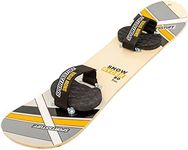Buying Guide for the Best Snowboard For Kids Beginner
Choosing the right snowboard for a beginner child is crucial to ensure they have a fun and safe experience on the slopes. The right snowboard will help them learn the basics more easily and build their confidence. When selecting a snowboard, consider the child's size, skill level, and the type of snowboarding they will be doing. Here are some key specifications to look at and how to choose the best fit for your child.LengthThe length of the snowboard is one of the most important factors to consider. It should be proportional to the child's height and weight. A shorter board is easier to maneuver and control, which is ideal for beginners. Generally, the board should come up to somewhere between the child's chest and chin. If the child is lighter or smaller for their age, opt for a shorter board within this range. If they are heavier or taller, a slightly longer board might be more appropriate.
WidthThe width of the snowboard should match the size of the child's feet. If the board is too narrow, their toes and heels will hang over the edges, which can cause them to catch in the snow and lead to falls. If the board is too wide, it will be harder for them to control. To find the right width, make sure the child's boots fit comfortably on the board with minimal overhang. This ensures better balance and control.
FlexFlex refers to how much the snowboard bends. For beginners, a softer flex is generally better because it is more forgiving and easier to control. Softer boards are more flexible and can help absorb bumps and uneven terrain, making the ride smoother and more comfortable. As the child progresses and gains more control, they might prefer a stiffer board for more stability and responsiveness.
ShapeSnowboards come in different shapes, such as directional, twin, and directional twin. For beginners, a twin shape is often recommended because it is symmetrical and allows for easier turns and riding switch (with either foot forward). This shape helps beginners learn the basics of balance and control more effectively. As the child becomes more experienced, they can explore other shapes that suit their riding style.
Camber ProfileThe camber profile of a snowboard refers to the shape of the board when viewed from the side. For beginners, a rocker or flat profile is usually best. Rocker boards have a curved shape that makes them easier to turn and less likely to catch an edge, which is great for learning. Flat boards offer a good balance of stability and maneuverability. Avoid traditional camber boards for beginners as they can be more challenging to control.
WeightThe weight of the snowboard can affect how easy it is for the child to handle and carry. Lighter boards are generally easier for kids to manage, especially when they are learning to carry their own gear. However, the weight should also be balanced with durability to ensure the board can withstand the wear and tear of learning. Look for a board that is lightweight but still sturdy enough to last through multiple seasons.





















